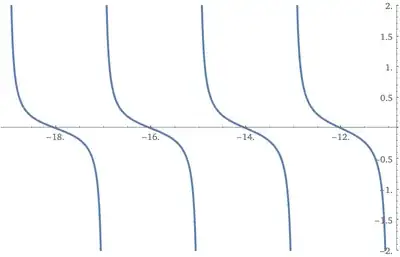For negative values of $x$, $$y= \frac{\Gamma(x+1)}{2^x\, \Gamma(\frac{x}{2}+1)^2} $$ is closer and closer to
$$\sin ^2\left(\frac{\pi x}{2}\right) \csc (\pi (x+1))=-\frac{1}{2} \tan \left(\frac{\pi x}{2}\right)$$ This comes from Euler's reflection formula of the gamma function.
Edit
As @GregMartin commented, I forgot the next term of the expansion. So, give all credit to him.
Using more terms, for negative values of $x$
$$y=- \sqrt{-\frac{2}{\pi x}} \tan \left(\frac{\pi x}{2}\right)\Bigg[ 1-\frac{1}{4 x}+\frac{1}{32 x^2}+O\left(\frac{1}{x^3}\right)\Bigg]$$
It could even be better if the series expansion is made a simple Padé approximant such as
$$\frac {64 x^2-8 x+11 }{64 x^2+8 x+11 }+O\left(\frac{1}{x^5}\right)$$
In order to check how good (or bad) is the approximation, I computed
$$I_n=\int_{-2n-0.99}^{-2n+0.99} \Bigg[\frac{\Gamma(x+1)}{2^x\, \Gamma(\frac{x}{2}+1)^2}+ \sqrt{-\frac{2}{\pi x}}\, \tan \left(\frac{\pi x}{2}\right)\,\,\frac {64 x^2-8 x+11 }{64 x^2+8 x+11 }\Bigg]^2\, dx$$
$$\left(
\begin{array}{cc}
n & I_n \\
10 & 5.371 \times 10^{-16} \\
9 & 1.766\times 10^{-15} \\
8 & 6.733\times 10^{-15} \\
7 & 3.105\times 10^{-14} \\
6 & 1.846\times 10^{-13} \\
5 & 1.567\times 10^{-12} \\
4 & 2.271\times 10^{-11} \\
3 & 7.961\times 10^{-10} \\
2 & 1.562\times 10^{-07}
\end{array}
\right)$$
What could be interesting is to see if we can approximate the roots of
$$\frac{\Gamma(x+1)}{2^x\, \Gamma(\frac{x}{2}+1)^2}=k $$


